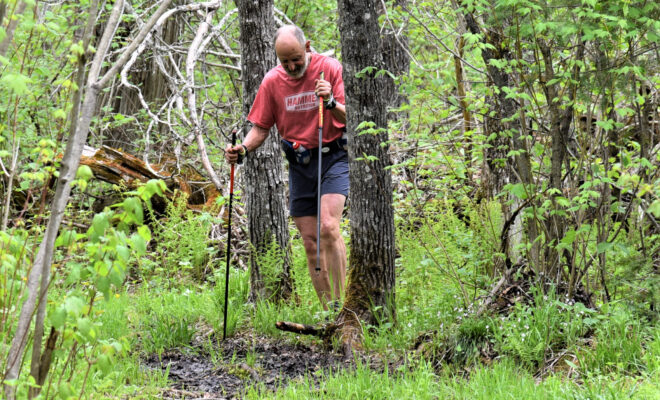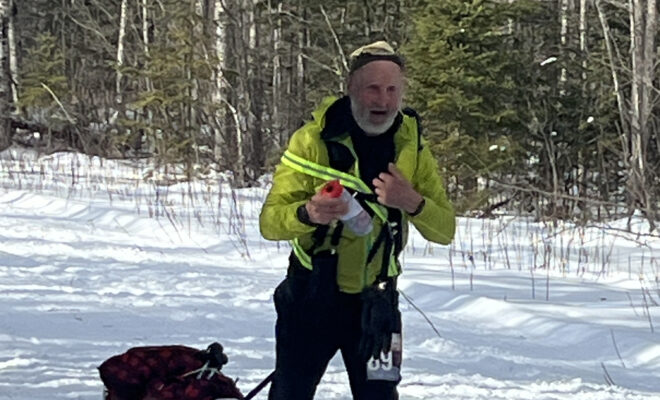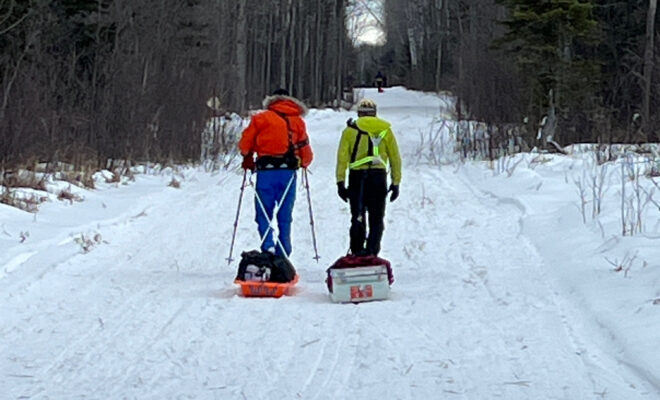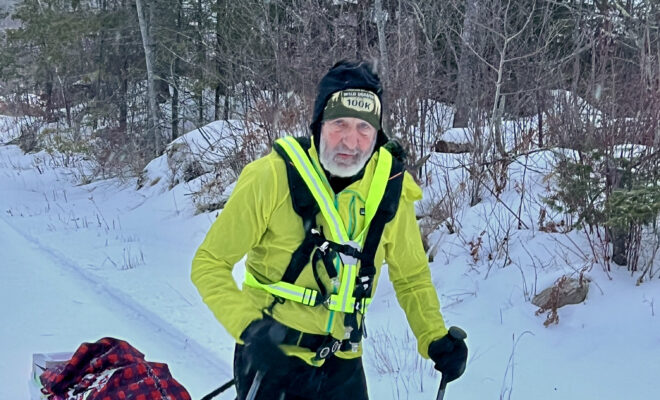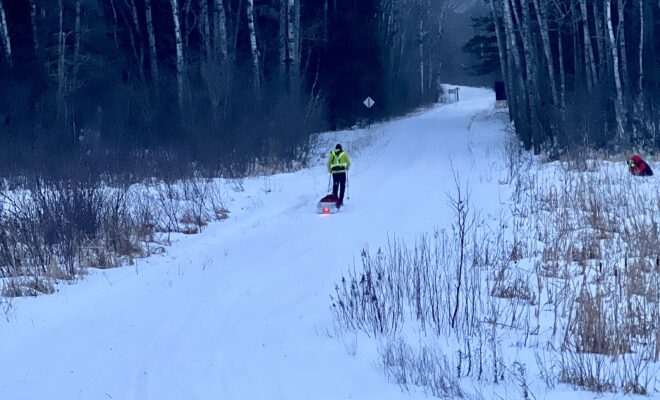Arrowhead 135 Ultra
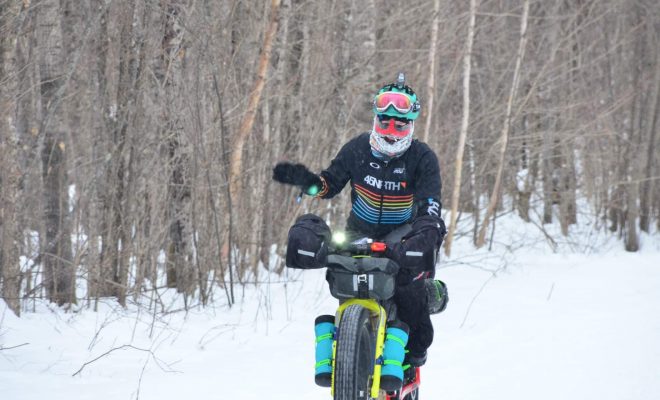
FAT BIKING
BY KIERSTIN KLOECKNER
“… there’s a silent voice in the wilderness that we hear only when no one else is around. When you go far, far beyond, out across the netherlands of the known, the din of human static slowly fades away, over and out.”
― Rob Schultheis
There are two types of endurance cyclists. Those who head out to conquer – conquer the elements, their opponents and the course. Then, there are those who see an event as a challenge and choose to honor the elements, their opponents and the course while they move as gracefully as they can from start to finish, taking time to enjoy the beauty, feel their bodies go through waves of elation and exhaustion and take whatever they can from the experience itself.
For those attempting the Arrowhead 135 Ultra, the former mentioned will rarely have fun in this demanding race. In fact, they may put themselves at risk of getting hurt if they are only focused on winning. The latter will, in a way, dance with what’s presented to them. They are pliable and aware of what is happening not only around them but within them. They will walk away, no matter what happens, a stronger and happier person than when they began.
As you read this, hopefully, you are experiencing a thaw with spring making itself known. As I write this, however, the Midwest just moved out of its polar vortex, followed by a series of snow and ice events. And in the midst of temps hovering around -25 actual temperature, and down to -60 windchill, Arrowhead 135 was taking place between International Falls and Fortune Bay, Minnesota.
Between those two points lie 135 miles of near-wilderness conditions. An area laden with wolves, bear, moose, owls, pine trees and not much else. Very few humans call this place home due to the severe winters and swarms of black flies and mosquitoes come spring. It is an area rich with history and strife, full of stories from the Native Americans, French trappers and then the loggers and outfitters. Only the hardiest call this home. Because of this, if one finds themselves in trouble, it could be a long trek to find help. People heading into this area must be confident in their wilderness skills (including reading a map and not relying on cell coverage or a GPS … something rare to find these days). They must have enough gear with them to survive if they get pummeled with snow or injured.
The organizers for Arrowhead make sure of this and have a lengthy list of gear requirements that must be carried from start to finish, otherwise, face elimination. Participants must also “apply” for the race to prove they have the stamina and wits so rescue crews won’t need to be sent out on a body search. So even if a racer is a “rookie,” they have a lot of endurance experience and they have proven they are critical thinkers while physically taxed.
I’ve been following the Arrowhead for 15 years. I was in awe of it the first year it ran. At that time, I had already fallen in love with dog sledding, skiing and winter camping in Northern Minnesota. I had not, however, fallen in love with biking, skiing or running 135 miles in under 60 hours. And although I have contemplated participating in it hundreds of times, reason has won out since I am at a greater risk for frostbite in both hands and feet. I’m quite happy following and cheering for friends though and hope next year to crew for one of them. Until then, I get to report on my friend’s experiences … one being a rookie who is known for putting on The Filthy 50 and The DAMn, and one being the women’s record holder who attempted the race completely unsupported. Meet Trenton Raygor and Jill Martindale, both whom I admire more than words can describe.
Question: What possessed you to take on Arrowhead 135?
Jill Martindale: When I was little, my mom and dad took the family on bike rides a lot. I started racing fat bikes after working at a bike shop because it was easy to get the time off in the winter. My love for riding all day long naturally meshed with riding fat bikes in the snow and it made me want to tackle the Iditarod Trail Invitational. Arrowhead is a qualifier, so I signed up to do my first one in 2016.
Trenton Raygor: I’ve been enjoying the Midwest gravel endurance scene for six or seven years now. No matter my intent going in, I always ride away feeling challenged, like I learned something new and I’ve been fortunate enough to make some great lifelong friends along the way. It was only this past year, when one of my favorite spring gravel events, Trans Iowa, announced its end that I decided to sign up for the Arrowhead. Why? Because my head shrinker says I need goals. Since my teens, I’ve struggled with depression, and I self-medicated by using some very unhealthy tactics. As the years roll by, I’ve discovered that an elixir of riding bikes and making music is just what my head needs for its mental well being.
Q: How did you prepare your mind and body for Arrowhead 135?
JM: I am a fairly active person and ride my bike or spend time outside whenever I can. My poor friends only see me if they join me during my workouts. I try to mix long rides up with interval training, jogs, core work and a healthy dose of fun rides with friends. I’ll usually do two to three medium rides per week, two days of hills or sprint intervals, and some active recovery days where I’ll move but not exert myself too much. Mentally, I look forward to being on the bike for a long time because I run out of things to think about, and I really enjoy having silence in my brain!
TR: I commute year round and wouldn’t have it any other way. Living in Minneapolis has made me love riding in the winter. I’ve been reading about Arrowhead for years. Past racers have been generous enough to share race reports as well as give me advice directly. I began strength training, I extended my commutes and I pushed harder. I even stopped drinking alcohol for the month of January. I would have done that regardless, but knowing a bottle of Willet Rye was waiting for me in a hotel room at Fortune Bay after a dry month was definitely a motivator.
Q: Everyone has extreme highs and lows during an event like this … could you talk a little about what you went through?
JM: Truthfully, I was really happy to be at Arrowhead almost the entire time! It always feels like a fun reunion with all my winter ultra friends, and I enjoy cheering for and rooting on the other riders when we pass each other, no matter how I’m feeling. I started the race out stoked, briefly got down on myself for getting sweaty, became okay with making slower time than I had wanted to and then weighed my options after passing Melgeorge’s (the second checkpoint). I had become wet with sweat, I kept stopping to drink out of an insulated thermos – thinking that I wanted to keep the water in my hydration pack for later, and my hips and knees weren’t happy with all the dismounts I took. I mentally began counting my calories and thinking about the food I had packed and got down on myself for not packing more sweets versus savory snacks since I was craving more chocolate and peanut butter. It was also mentally hard seeing my husband at the checkpoints, because of racing unsupported, he was my reminder I wasn’t allowed indoors. On one hand, I’m bummed I didn’t finish unsupported this year, on the other hand, I feel happy I didn’t let myself get frostbite or hypothermia. Part of doing an event like this is knowing when to call it when you realize it’s not in the cards.
TR: The highs were frequent for me. During the first 10 miles, my friend Charles Parsons rode up to me and started singing, “Jesus rides beside me, he never buys any smokes.” I returned with “Hurry up, hurry up, ain’t you had enough of this stuff … ashtray floors, dirty clothes and filthy jokes.” We both kept singing and then discussed the history of The Replacements which really made the miles tick by. Toasting the day with some whiskey atop of a hill at 1:00 p.m. was a true high point. Seeing my dad and my friend, Mario, at the checkpoints, also gave me a little buzz. The highest point for me was sandwiched between some pretty low lows. During the hilly section between checkpoints two and three, I was walking the bike a lot and my knees were angry (something Trenton had dealt with the entire month prior … to the point he couldn’t ride for three weeks before the race). I was hoping to enjoy the descents, but my brakes had frozen over leaving me bombing large hills at 40 mph in the trees without much visibility, sometimes dragging a leg to try and slow down. It was a bit frightening. While pushing the bike up a large hill, knees throbbing, I thought about my friend, Ben, who’s only pre-race advice was, “listen to the trees.” I listened and looked at the stars and the most beautiful crescent moon. I thought about all of the life surrounding me, as well as the life that lived there in those hills centuries ago. I found solace in that, and after a few minutes, I moved on feeling better … until I ran out of water about ten miles after checkpoint three. I still had an insulated bottle on my bike, and I could see liquid through the container, but try as hard as I could, I couldn’t get the bottle open. This was a low point for me. I jammed all my gear back into my saddle trunk and got on the bike. I was weak and in pain but knew I had to time trial it in. For the first time, I pushed play on my earbuds … all of a sudden I hear, “Go home … this is the Minneapolis police … the party’s over … if you all just grab your stuff and leave there won’t be any hassle … the party’s been closed … ONE, TWO, THREE, FOUR!” At this point, I’m literally standing in the middle of a frozen swamp laughing out loud. My spirits were restored. I put my head down and slowly hammered away the miles.
Q: Do you see more winter endurance events in the future?
JM: Absolutely! I am going to keep coming back until I finish the Arrowhead unsupported. I think if you DNF at a race, it’s the best fuel to get back out there and finish it. I’ve finished it twice supported (in 2017 Jill won the women’s record), and I’ve dropped twice unsupported. I think 2020 is the year I put the last two DNFs to use and finally finish! My goal this year was to go after the Order of the Hrimthrus, but since I didn’t have the finish I was hoping for at Arrowhead, that’s kind of tossed out the window. Rather than sulk, be bummed out or beat myself up over it, I’ve decided to head to Fairbanks, Alaska, this March for the White Mountains100! It’s a different style than Arrowhead unsupported, but I’m so excited to get back to Alaska again. I’ve heard great things about that race, and I’m so thrilled to have some beautiful views and daydream about living in Alaska some day.
TR: Most definitely. Let’s be honest, though … throughout a race like Arrowhead, I’m like a drug addict lying on his back in a Tijuana hotel room. I would like to race Tuscobia and a few other winter races if I can get away. However, I need to make sure not to disrupt the healthy balance between bikes and family. Who knows, maybe someday I’ll attempt the Arrowhead in the ski division.
Although on average, about 50 percent of the racers finish, this year it was far below that due to the extreme cold. A new men’s record was set, however, by Jordan Wakeley. Overall, with 147 starting, 39 cyclists crossed the finish line, as well as 13 runners. There’s something so special that bonds those who attempt Arrowhead 135, and I can’t thank Jill and Trenton enough for giving me a glimpse inside their experience!


